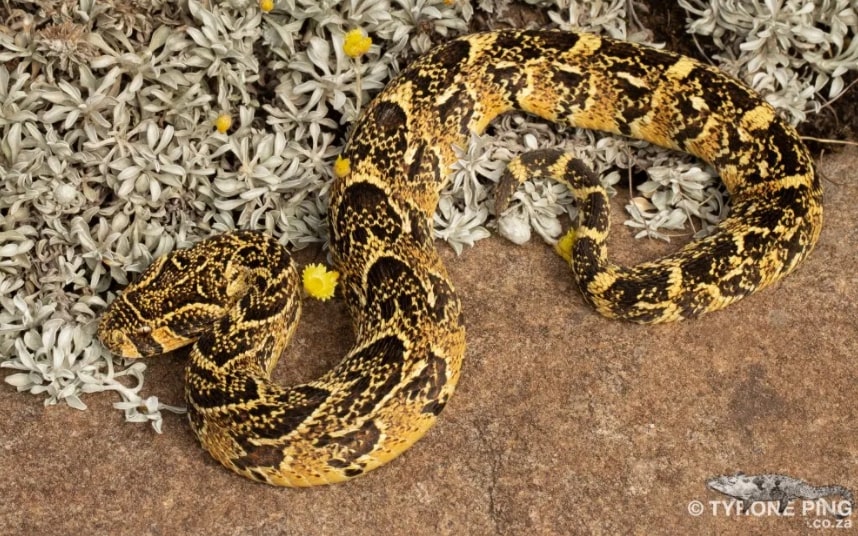The Western Cape is no stranger to scaly creatures. Some of the most venomous snakes in the world reside here, and since most Capetonians love the Mountain and the outdoors, it would be wise to learn about them.
We spoke to reptile and amphibian expert and photographer Tyrone Ping about the snakes of the Cape, and what to do should you encounter one.
When are snakes most likely to be out and about?
Typically, the peak in snake activity coincides with the warmer temperatures towards the end of spring and well into summer which is well known as “snake season”, so November through to March. This is when many other animals are reproducing and birds are nesting, and so do the snakes, which means their activity increase.
However, the Puff Adders In the Western Cape mate during the winter months so they may still be seen regularly during winter. Contrary to popular belief, snakes will typically avoid the hottest times of the day, so they may be seen basking in the early mornings and late afternoons, seeking shade or venture in holes during the hotter part of the dry summer days.
In which environments should Capetonians be most alert for snakes?
With Cape Town being nestled between mountains its not uncommon for many walkers and hikers to come across snakes. Fynbos is so dense and usually difficult to notice snakes in, so the chances of seeing snake are quite slim. They are usually only noticed at the last minute as it crosses the path in front of you or quickly darts off into the bushes. Anywhere you can find open, well-vegetated spaces, trees and natural habitat, there is a good chance you may find snakes there.
What should someone do if they come across a snake in the outdoors?
The best thing you can do is give the snake a wide berth and put at least 3m between yourself and the snake. Never try to pick up the snake, using a stick to poke or move the snake, as this usually agitates the snake causing it to possibly strike out in self-defence if it feels threatened.
What should someone do if they get bitten/spit at? How can it be prevented?
Any snakebite should be treated as a medical emergency and following any bite or even suspected bite medical personnel should be alerted immediately. While keeping the victim as calm as possible, remove any tight-fitting clothing, rings or bracelets that may interfere with a swollen arm/leg or finger. Get to any hospital that has a trauma unit, you don’t have to factor in which hospital may or may not have antivenom.
When it comes to venom in the eyes (there are no spitting snakes in Cape Town itself), the venom should be immediately flushed out of the eyes with water for several minutes. The best would be under running water like a tap or hosepipe for 10-15minutes after which a visit to the local doctor is advised to check there is no damage done to the eye. If the venom lands on the skin it can simply be wiped away, there is only potential harm if the venom lands in a freshly opened wound and enters the body, although the chances of this are rather slim.
How common are the very venomous snakes in the Cape?
The most common venomous snakes in the Cape are the Cape Cobra, Boomslang and Puff Adder, all of which are really common. These snakes are commonly found in suburban gardens and built-up residential areas.
Are any of the Cape’s snakes endangered?
There are no specific endangered or at risk snakes in the Cape thankfully, although snakes, in general, are at great risk of habitat destruction, frequent burning and of course road mortalities. This is especially true up on the West Coast where the highways pass through pristine wild areas.
Do you have a favourite snake?
There are simply so many to choose from, although I am particularly fond of the Shovel Nose Snakes (which feed exclusively on gecko eggs) – amazing specialised diets!
Here are some of the Cape’s most venomous snakes and interesting facts about them from Tyrone’s website.
Cape Cobra (Naja nivea) HIGHLY VENOMOUS
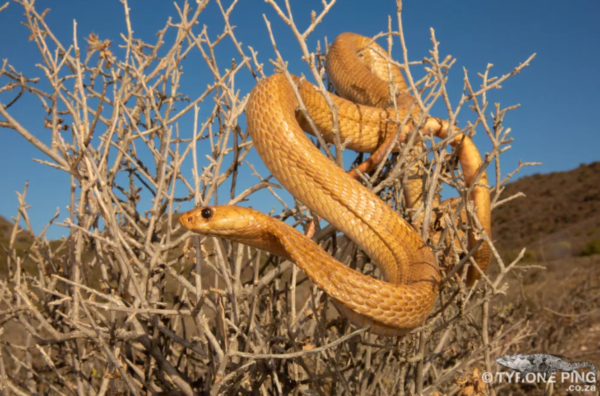
Africa’s most potent species of Cobra having a mainly neurotoxic venom with neurotoxic properties these snakes do not spit/spray their venom. Polyvalent anti-venom is used in the effective treatment of bites. The Cape Cobra is extremely common in the Western Parts of South Africa including Cape Town. Favouring drier arid environments as well as fynbos biomes including table mountain and surrounds.
These snakes are highly variable in colour and can be bright yellow, yellow with black speckles, sandy brown, dark brown almost blackish and pale yellow almost grey in colour in some parts. Juveniles have a prominent black throat band which fades with age. Unlike most cobra species they are also well-known to have a black tail tip which is a key indicator between the Cape Cobra and Snouted Cobra.
Cape Boomslang (Dispholidus typus viridis) HIGHLY VENOMOUS
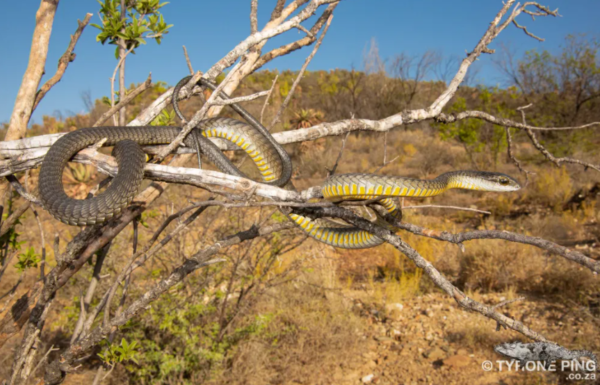
These snakes are strictly tree-dwelling animals and seldom venture down to the ground, with the exception being to feed or drink. They are one of the few snakes in Southern Africa that are sexually dimorphic (generally), meaning that the males and females feature different colouring. One of the few snake species which is generally sexually dimorphic, often the males are black and yellow, and the females dull brown/grey or olive. Juvenile snakes are brown/grey with speckles, and have a brilliant emerald-green eye.
Averaging around 1.5m in length, Boomslangs can often reach close to 2m. These snakes rarely bite people, and are docile in nature. They possess a potent haemotoxic venom, for which there is an anti-venom available. It solely deals with bites from these snakes, and is called a monovalent anti-venom. There are no green Boomslang found in Cape Town.
Puff Adder (Bitis arietans) – HIGHLY VENOMOUS
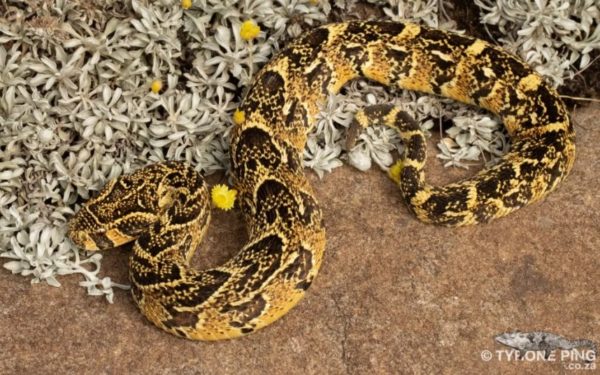
Probably South Africa’s most widely-spread, common venomous snake, the Puff Adder is relatively common in Cape Town and is often seen on hiking trails. The Puff Adder is a snake with excellent camouflage, and it prefers to sit and wait for an opportunity when it comes to feeding. These snakes may remain in an ambush position for several weeks, waiting for a potential meal to pass by. They have a powerful cytotoxic venom which can lead to extreme pain, severe swelling, and blistering of the skin.
Berg Adder (Bitis atropos) HIGHLY VENOMOUS
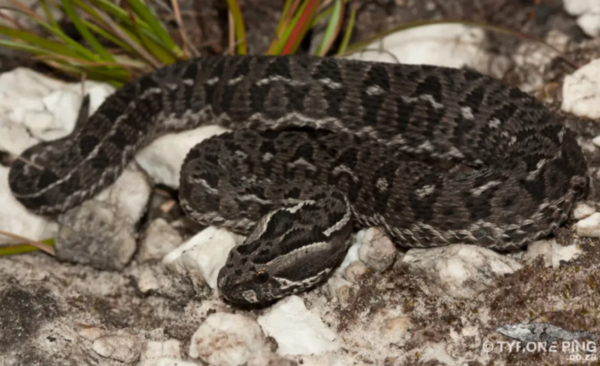
Averaging 30 cm but specimens may reach 60 cm. A short stocky snake, which ranges in colours from charcoal black, with a number of lighter or darker patches along the back. These snakes have a short temper that will hiss and struck out violently when accosted. There are more or less three distinctive populations of Berg Adders in South Africa. Typically favouring rocky high altitude montane regions associated with grasslands in the East, although in the Eastern and Western Cape they may be found at sea level.
Often sheltering under rocks and beneath grass tussocks, commonly seen basking on hiking paths on Table Mountain. Bites are uncommon and the venom seems to have largely neurotoxic properties which in some cases may cause prolonged effects on the senses. Affecting sense of smell, taste and sight in extreme cases. Like most dwarf adders they are heavily collected for the illegal pet trade both locally and internationally. Antivenom is not used nor effective in the treatment of these bites.
Pictures: Tyrone Ping




